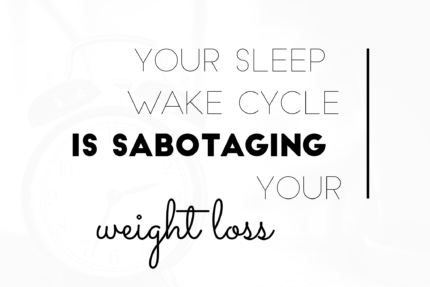You have been eating your fruits and vegetables, healthy fats, protein, and exercising at least four times a week. You step on the scale and there’s no change. If I were to ask those of you reading this to raise your hand if you’ve had a similar experience, I’m sure at least 75% of you would be jumping out of your chair. Weight-loss resistance is a common problem I see in my practice. So much so that I wrote a book on it! Would you believe me if I told you that your sleep-wake cycle might be the culprit?
Let’s start with homeostasis
The intricacies of our body are a beautiful thing. Different systems work together to maintain a state of balance, called homeostasis. For example, if you have high blood pressure, your body will increase urination in order to reduce the total amount of fluid and decrease blood pressure. Your body is so smart; it will do whatever it has to do to bring us back to balance.
Another system that we need to balance is time spent in rest mode, sleeping, with time awake and living. These actions are influenced by a 24-hour cycle called our circadian rhythm. Not only does our circadian rhythm affect our sleep-wake time, it affects systems like our hormones, eating patterns and body temperature.
What about wrist temperature?
Knowing that our circadian rhythm affects most body systems, a non-invasive way to assess the 24hr clock is by measuring our wrist temperature. In ideal body weight individuals, wrist temperature has high values during sleep, low values upon waking, and then it should cycle throughout the day with meals and activity.1 In a study looking at circadian rhythm and weight loss, researchers categorized women as either losing body weight or gaining weight during an assigned program1-2.
The findings were astonishing, if you had a proper wrist temperature cycle, meaning it dropped upon waking and cycles through the day then you were likely to lose weight. The study also noted that those women with the least variability in temperature rhythm were also the least likely for the weight loss intervention to work1-2.
Improving my circadian rhythm
As most of us know, weight loss can be a complex goal. That’s not to say it’s impossible, but it’s more than just calories in less than calories out. What I see in practice proves that many women are dealing with this issue so it’s important that research is looking at other pieces of the puzzle.
Most of you are probably wondering if you should start tracking your wrist temperature. This is an options but the watch technology we currently have isn’t quite adequate enough. What you can do though is take steps to set a consistent bed time (preferably before 11pm) and waking time, avoid blue light from a TV screen, phone or tablet and avoiding eating late at night.
A few simple changes can evidently have a big impact!
For more information on this, stay tuned for updates about my upcoming book, Lose It.
References:
- Bandín, C., Martinez-Nicolas, A., Ordovás, J. M., Madrid, J. A., & Garaulet, M. (2014). Circadian rhythmicity as a predictor of weight-loss effectiveness. International Journal of Obesity (2005), 38(8), 1083–8. https://doi.org/10.1038/ijo.2013.211
- Corbalán-Tutau, M. D., Madrid, J. A., Ordovás, J. M., Smith, C. E., Nicolás, F., & Garaulet, M. (2011). Differences in daily rhythms of wrist temperature between obese and normal-weight women: associations with metabolic syndrome features. Chronobiology International, 28(5), 425–33. https://doi.org/10.3109/07420528.2011.574766

